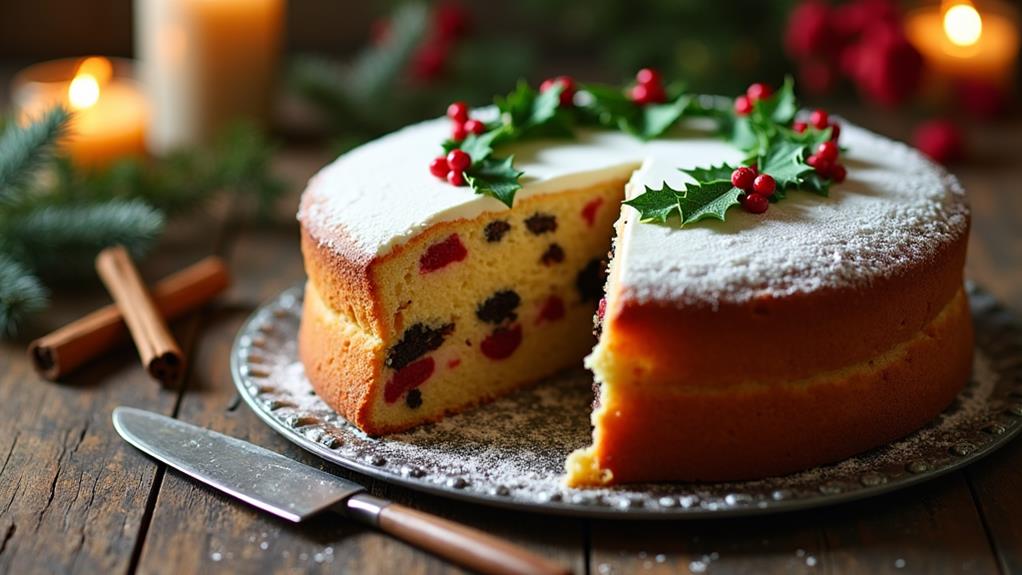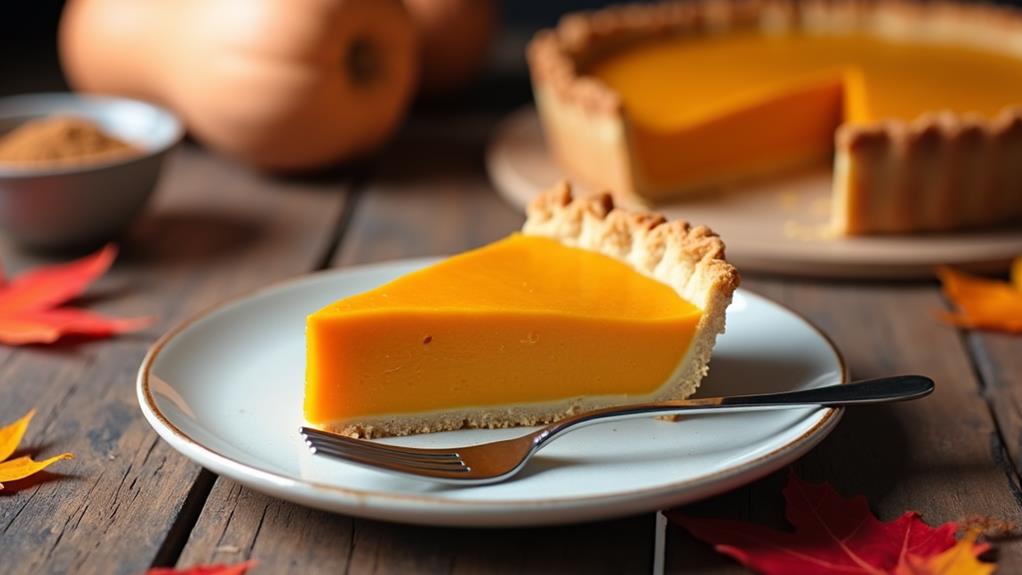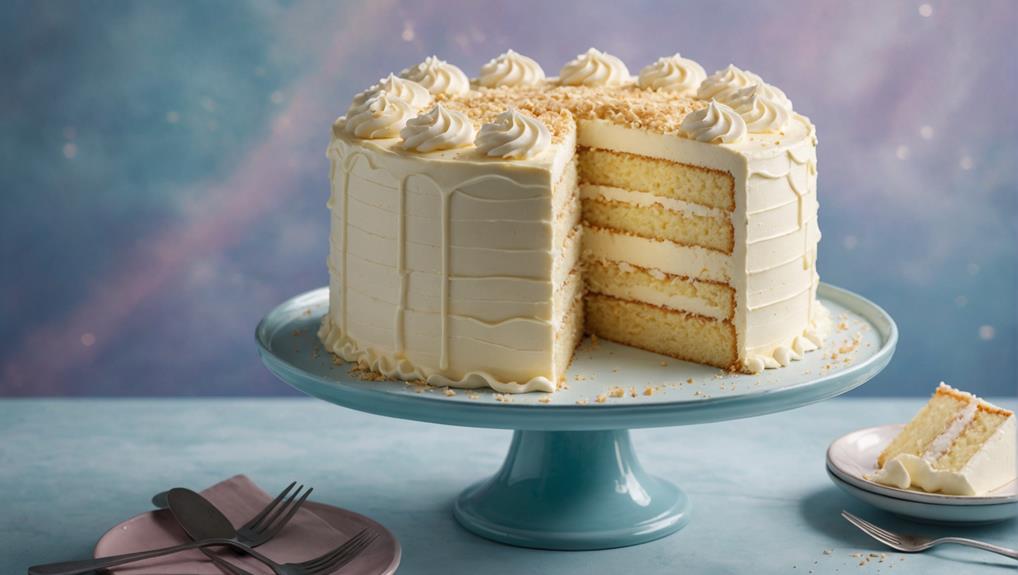As the holiday season wraps its cozy arms around you, the aroma of a classic Christmas cake beckons like a warm embrace. You've likely encountered this rich, fruity delight at festive gatherings, but have you ever considered making one yourself? This timeless dessert carries centuries of tradition and a wealth of flavor within its dense, moist crumb. Whether you're a seasoned baker or a curious novice, understanding the history and mastering the technique of this holiday staple can elevate your seasonal celebrations. Let's uncover the secrets behind this iconic treat and explore how you can create your own showstopping centerpiece.
Key Takeaways
- Classic Christmas cake is a rich, fruit-filled dessert traditionally associated with holiday celebrations.
- Key ingredients include dried fruits, brandy or rum, flour, sugar, and eggs.
- The process involves soaking fruits in alcohol, mixing ingredients, and baking for about 2 hours.
- The cake is typically wrapped and stored for several weeks to enhance flavor and moisture.
- Decorations often include marzipan and royal icing, making it a festive centerpiece for holiday gatherings.
History
Dating back centuries, the Christmas cake has its roots in medieval England. You'll find its origins in a traditional porridge called 'frumenty,' which was made with wheat, currants, and spices. Over time, this humble dish evolved into a sweet, fruity pudding that became the precursor to the modern Christmas cake.
By the 16th century, you'd see the addition of eggs, dried fruits, and spices, transforming the dish into a plum cake. This cake became associated with Christmas festivities, as families would prepare it at the end of the harvest season, allowing it to mature for the holiday feast. The tradition of 'feeding' the cake with alcohol began during this period, enhancing its flavor and preserving it for longer.
In the Victorian era, you'd witness the cake's transformation into the rich, decorative dessert we know today. Bakers began covering the cakes with marzipan and royal icing, creating elaborately decorated confections that became centerpieces of Christmas celebrations.
This tradition spread throughout the British Empire, leading to various regional adaptations of the Christmas cake worldwide.
Recipe
The Classic Christmas Cake is a quintessential holiday dessert that embodies the spirit of the season. Rich with dried fruits and infused with brandy or rum, this cake is a delightful treat that brings warmth and cheer to festive gatherings.
This simplified version of the Classic Christmas Cake uses just five key ingredients to create a moist, flavorful dessert that captures the essence of the traditional recipe. By preparing the cake in advance and allowing it to mature, you'll achieve a depth of flavor that makes this dessert truly special.
- 2 cups (300g) mixed dried fruits
- 1 cup (240ml) brandy or rum
- 2 cups (240g) self-rising flour
- 1 cup (200g) brown sugar
- 3 large eggs
In a large bowl, combine the mixed dried fruits and brandy or rum, stirring well to coat the fruit. Cover and let soak overnight.
The next day, preheat your oven to 300°F (150°C). Add the flour, brown sugar, and eggs to the soaked fruit mixture, stirring until well combined. Pour the batter into a greased and lined 8-inch (20cm) round cake tin. Bake for approximately 2 hours, or until a skewer inserted into the center comes out clean.
Allow the cake to cool completely in the tin before removing and wrapping in parchment paper and foil.
For best results, store the cake in an airtight container for at least a week before serving, allowing the flavors to mature. You can "feed" the cake by unwrapping it once a week and drizzling with additional brandy or rum before rewrapping. This will enhance the cake's moisture and flavor.
When ready to serve, you can decorate the cake with a simple dusting of powdered sugar or opt for traditional marzipan and royal icing for a more festive appearance. If you prefer a non-alcoholic version, you can substitute the brandy or rum with fruit juice, although this may affect the cake's preservation qualities.
Cooking Steps
To create your Classic Christmas Cake, you'll start by soaking the dried fruits in alcohol overnight, allowing them to absorb the rich flavors.
The next day, you'll mix the dry ingredients before combining them with the soaked fruit and eggs to form a thick, fragrant batter.
Step 1. Soak Fruit in Alcohol
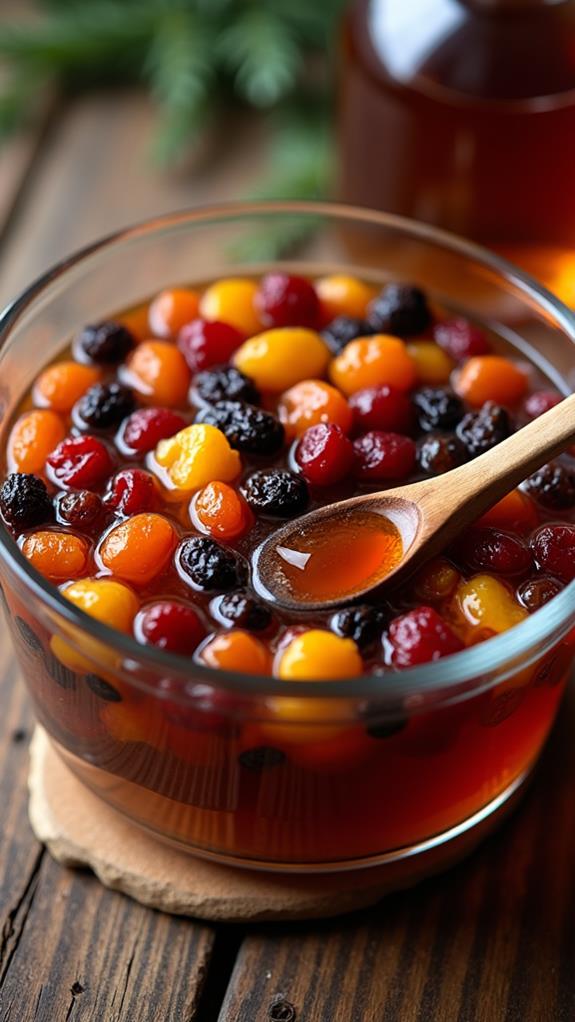
Fruit-soaking is the crucial first step in creating your Classic Christmas Cake. Begin by selecting a mixture of dried fruits, which may include raisins, currants, sultanas, and candied peel. Measure out 2 cups (300g) of this fruit blend and place it in a large, non-reactive bowl.
Pour 1 cup (240ml) of brandy or rum over the fruit, ensuring that all pieces are well-coated. Use a spoon to stir the mixture thoroughly, distributing the alcohol evenly.
Once you've combined the fruit and alcohol, cover the bowl tightly with plastic wrap or a lid. This prevents the alcohol from evaporating and keeps any contaminants out.
Place the covered bowl in a cool, dark place, such as a pantry or cupboard, and let it sit overnight. During this time, the dried fruit will absorb the alcohol, becoming plump and flavorful.
The soaking process not only enhances the taste of your cake but also contributes to its moist texture. If you have the time, you can extend the soaking period up to several days for an even more intense flavor profile.
Step 2. Mix Dry Ingredients
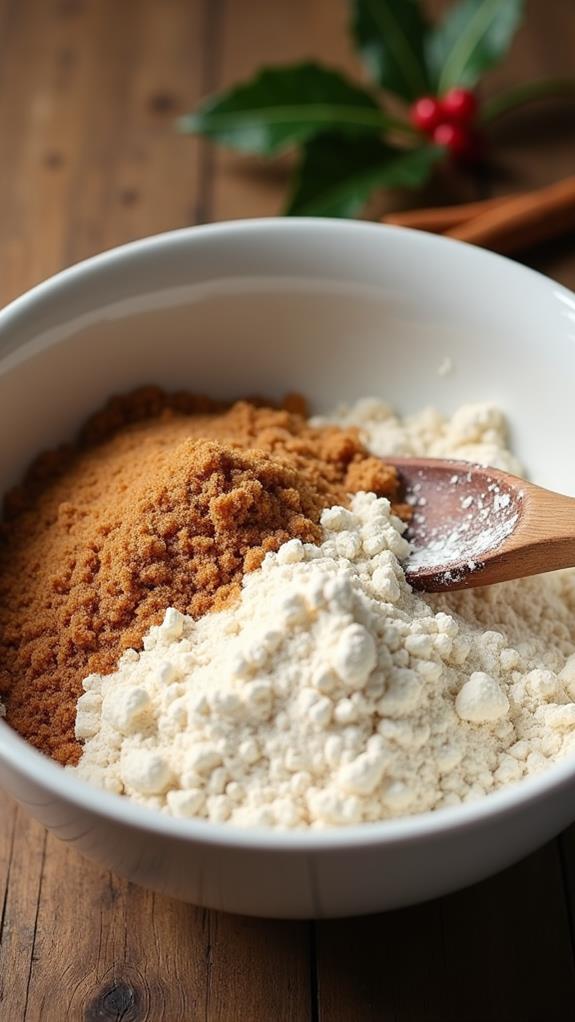
After soaking the fruit, it's time to prepare the dry ingredients for your Classic Christmas Cake. In a large mixing bowl, measure out 2 cups of self-rising flour. This type of flour already contains leavening agents, simplifying the recipe and ensuring a consistent rise.
Next, add 1 cup of brown sugar to the bowl. The molasses content in brown sugar will contribute to the cake's rich flavor and moist texture.
Using a whisk or fork, thoroughly combine the flour and sugar, breaking up any lumps in the brown sugar. This step is crucial for achieving a smooth batter and evenly distributed sweetness throughout the cake.
Once mixed, create a well in the center of the dry ingredients. You'll use this space to add the wet ingredients later, making it easier to incorporate everything without overmixing.
Step 3. Combine Wet and Dry Ingredients
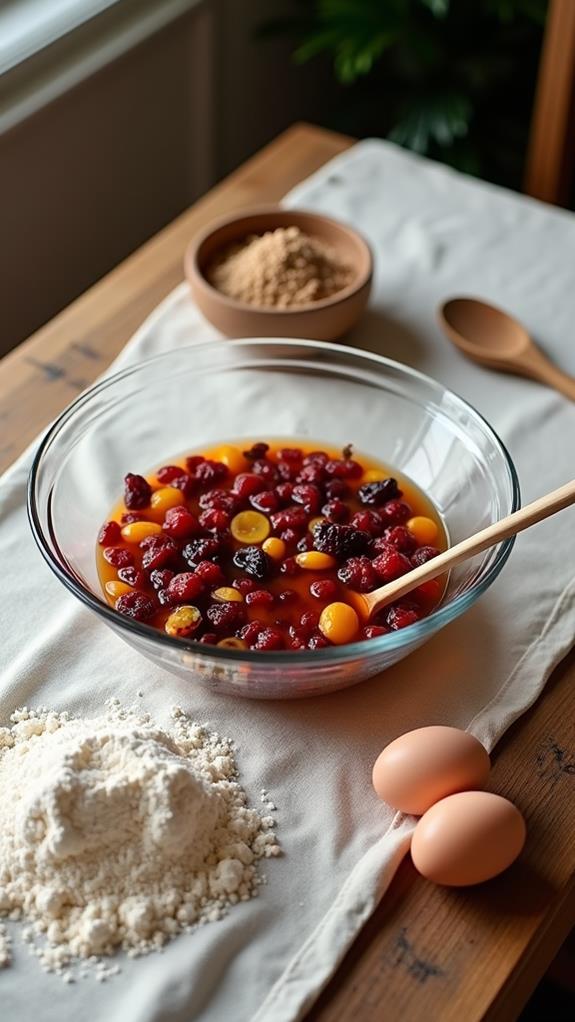
Now that you've prepared your dry ingredients, it's time to bring everything together. Start by retrieving your soaked fruit mixture from its overnight rest. The fruits should have absorbed much of the brandy or rum, becoming plump and flavorful.
Add the pre-mixed dry ingredients to this fruit mixture, ensuring you scrape the sides of the bowl to incorporate all the flour and sugar.
Next, crack the eggs into a separate bowl and lightly beat them with a fork. This step helps distribute the eggs evenly throughout the batter. Pour the beaten eggs into the fruit and flour mixture, then use a wooden spoon or spatula to fold everything together.
Stir gently but thoroughly, making sure there are no pockets of dry flour remaining. The batter will be thick and sticky, with the fruits evenly distributed throughout.
As you mix, you'll notice the aroma of spices and alcohol mingling with the fruity scents. This is a good sign that your cake is coming together properly.
Continue folding until the batter has a consistent texture and color throughout.
Step 4. Bake in Preheated Oven
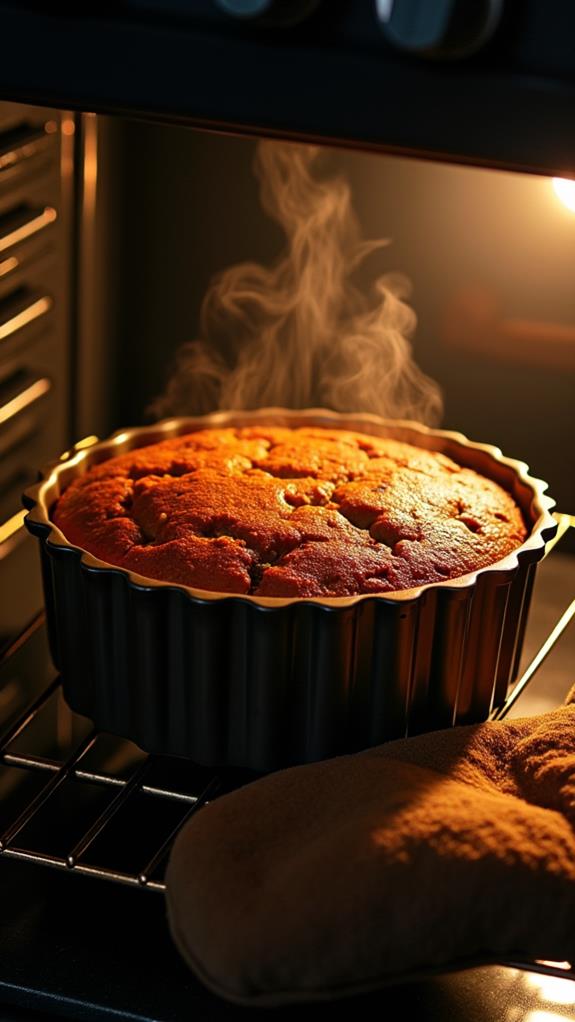
With your cake batter fully mixed, it's time to transfer it to the prepared baking tin. Carefully pour the batter into your greased and lined 8-inch round cake tin, ensuring an even distribution.
Gently tap the tin on the counter a few times to release any air bubbles trapped in the mixture.
Place the filled tin in your preheated oven, set to 300°F (150°C). Position it on the middle rack for even heat distribution. You'll need to bake the cake for approximately 2 hours, but start checking it after 1 hour and 45 minutes.
To test for doneness, insert a skewer or thin knife into the center of the cake. If it comes out clean, your cake is ready. If not, continue baking and check every 10 minutes.
Once fully baked, remove the cake from the oven and let it cool completely in the tin. This cooling process is crucial for the cake's structure and flavor development.
Resist the temptation to remove it too soon, as this could cause the cake to crumble or lose its shape. After cooling, carefully remove it from the tin and wrap it tightly in parchment paper and foil for storage.
Step 5. Cool and Wrap Cake
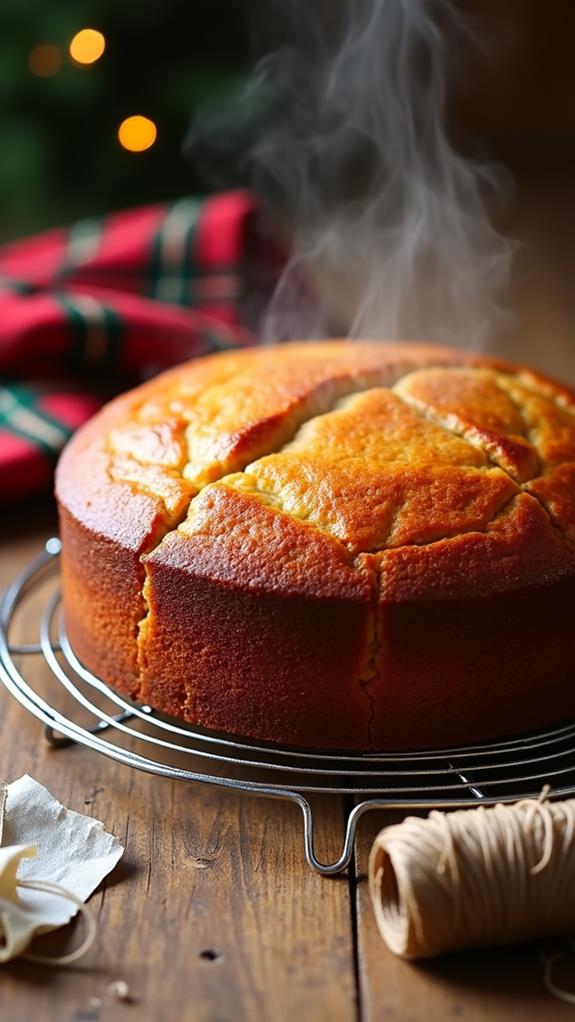
The cooling process is just as important as baking for your Christmas cake. Once you've removed your cake from the oven, resist the temptation to unwrap it immediately. Instead, let it cool completely in the tin, which can take several hours. This gradual cooling helps maintain the cake's structure and prevents it from crumbling when you remove it.
After the cake has cooled, carefully remove it from the tin and peel off the parchment paper.
Now, it's time to wrap your cake for storage. Start by placing a fresh sheet of parchment paper directly on the cake's surface. Then, wrap the entire cake tightly in aluminum foil. This double-layer wrapping serves two purposes: it prevents the cake from drying out and protects it from absorbing any unwanted flavors from your storage area.
Store your wrapped cake in an airtight container in a cool, dark place. If you've planned ahead, you can now begin the process of "feeding" your cake with additional brandy or rum over the coming weeks, enhancing its flavor and moisture content before the holiday festivities begin.
Final Thoughts
Simplicity lies at the heart of this Classic Christmas Cake recipe. You'll find that with just five key ingredients, you can create a delicious and festive dessert that captures the essence of the holiday season. By focusing on quality components and allowing time for flavors to develop, you'll achieve a rich, moist cake that rivals more complex versions.
Remember, patience is crucial when making this cake. The initial soaking of fruits and the post-baking maturation period are essential steps that shouldn't be rushed. These processes contribute significantly to the cake's depth of flavor and texture.
Don't hesitate to experiment with different dried fruit combinations or liquors to suit your taste preferences. You can also personalize your cake with various decorations, from a simple dusting of powdered sugar to elaborate icing designs.
Whether you're an experienced baker or a novice in the kitchen, this streamlined recipe offers an accessible way to participate in the time-honored tradition of Christmas cake-making. By following these straightforward instructions, you'll create a memorable centerpiece for your holiday table that's sure to impress family and friends.

